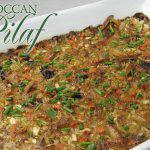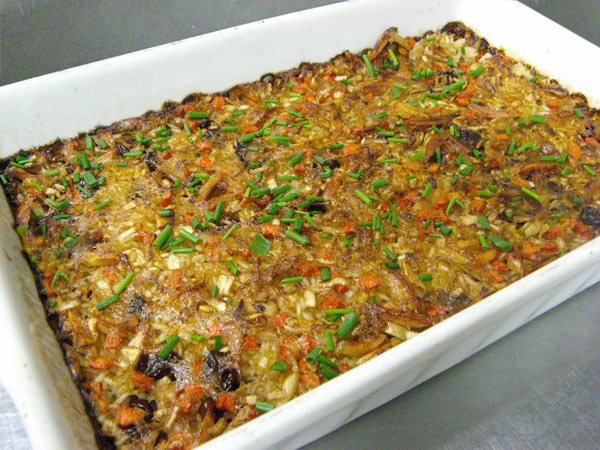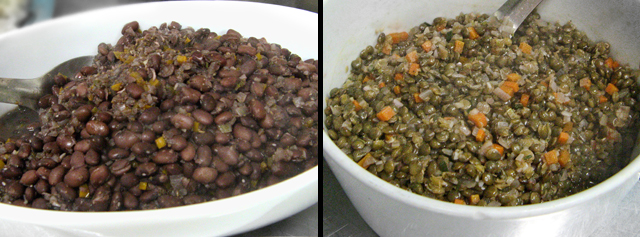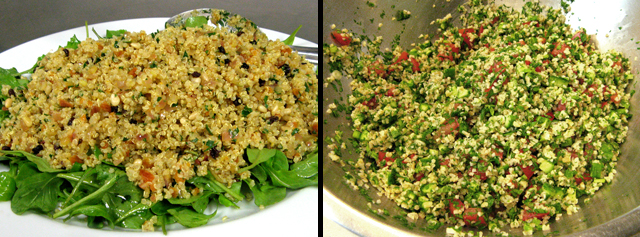Methods & Madness… Class 8: Pasta #1
Recipes & Ramblings from Chef School
If I told you we are learning about plants, grasses and seeds in school this week, you might think I took a wrong turn and ended up at a gardening class… not so. We learned about nutritious foods that our ancestors ate. Today’s recipe is a contemporary twist on an old classic.
Loveable Legumes
Legumes are plants with seedpods. The seeds are released by splitting open along two seams. Edible seeds in the legume family include beans, peas, lentils, soybeans, and peanuts. Some seeds are eaten fresh, canned, frozen, dried or as flour.
Legumes are rich in protein, fiber, B vitamins, minerals and disease-fighting phytochemicals, low in sodium as well as gluten free. They are inexpensive, versatile, and have a long shelf life. What more could one want?
To prepare dried legumes
- Remove stones or shriveled beans.
- Put in pot with cold water — remove any that float to the top as they are too dry for culinary or nutritional value.
- Drain and rinse well.
To soak or not to soak
The culinary jury is still out on this one, but my research says soak.
Benefits
- Softens skin for more rapid and even cooking
- Creamier texture
- Activates enzymes that break down indigestible starches and sugars which are responsible for flatulence as they ferment in your gut producing gas.
Two methods of Soaking
- Long Soak — Place in pot, add water to cover by 2 inches. Soak in refrigerator four hours or overnight.
- Short Soak — Place in pot, add water to cover by 2 inches. Bring water to simmer. Remove pot from heat and cover. Let steep for one hour.
Proper cooking techniques would include simmering or steaming.
TIP: Don’t boil legumes, as high heat will make them tough, as will adding salt to your beans while cooking.
Gratifying Grains
Grains are a staple in the diets of cultures around the world and have made an important contribution to daily nutrition since cultivation began around 10,000 B.C.
In their natural state growing in the fields, whole grains are the entire seed of a plant. This seed is made up of three key parts: the bran, the germ and the endosperm.
Whole grains may reduce the risks associated with heart disease, stroke, cancer, diabetes and obesity. Whole grains may be eaten whole, cracked, split or ground. They can be milled into flour or used to make breads, cereals and other foods.
Fun Fact: One of the most popular whole grain foods is popcorn.
Cereals and Meals
Cereals are grasses whose seeds are used as food grains. Cereal grains are excellent sources of complex carbohydrates, low in fat, and good sources of protein, fiber, vitamins and minerals.
Meals are whole grains that are ground until they have the consistency of sand.
- Cereals — wheat, rice, millet, oats, bulgar, barley, maize and rye
- Meals — grits, polenta, semolina, and cream of rice
Renowned Rice
Rice has fed more people over a longer period of time than any other crop dating back as far as 2500 B.C. Worldwide there are more than 40,000 varieties of rice.
Rice is classified mostly by the size of the grain.
- Long-grain rice is long and slender. The grains stay separate and fluffy after cooking, so this is the best choice if you want to serve rice as a side dish, or as a bed for sauces.
- Medium-grain rice is shorter and plumper, and works well in paella and risotto.
- Short-grain rice is almost round with moist grains that stick together when cooked. It is very starchy and the best choice for rice pudding and sushi.
Most varieties are sold as either brown or white rice, depending upon how they are milled.
Brown rice retains the bran that surrounds the kernel, making it chewier, nuttier, and richer in nutrients. Brown rice takes about twice as long to cook as white rice.
White rice is more tender and delicate, but lacks the bran and germ, hence it’s less nutritious than brown rice.
Wild rice is not really rice at all. Wild rice is a remote relative of white rice, actually a long-grain, aquatic grass. It is richer in protein and other nutrients, and it has a more distinctive and nutty flavor.
Rona covers cooking rice in her blog, click here to check it out.
We also learned about pasta which I have included in a part two of this post. Click here to read about pasta and a recipe for Potato Gnoochi with Brown Butter Sauce that I made in class. Rona made Basil Pesto on Linguine and Bucatini all’Amatriciana.
Click here to read her post and get the recipes.
Homework Assignment
I was quite mesmerized by the Moroccan Rice Pilaf we ate in class, so that is the recipe I’ll share with you. I served it with Spice Rubbed Salmon.

Moroccan Rice Pilaf
Ingredients
- 2 tablespoon olive oil
- 1/3 cup blanched slivered almonds
- 1 small onion chopped
- 1 carrot peeled and cut into ¼ inch dice
- ½ teaspoon ground cinnamon
- 1 teaspoon salt
- 1 cup long grain rice
- 3 cups chicken stock
- 1/3 cup dried tart cherries
- minced zest of 1 orange
- ¼ teaspoon cayenne pepper
- 1 ½ tablespoons snipped fresh chives
Instructions
-
Preheat oven to 375 degrees. Lightly oil a shallow 1½ quart casserole dish.
-
Heat the oil in a large skillet, and sauté the almonds over medium heat until they are browned and fragrant, 3 minutes. Stir in the onion, carrot, cinnamon and salt. Cook 3 minutes.
-
Add the rice and cook, stirring, until translucent.
-
Stir in the stock, cherries, orange zest and cayenne pepper. Bring to a boil. Remove from heat.
-
Transfer mixture to the prepared casserole and bake, uncovered until the liquid has been absorbed and rice is tender, about 45 minutes. Sprinkle with chives and serve.
Recipe Notes
Cook time: 45 mins - Serves 6
“Legumes offer a host of health benefits that make them a highly sought after, non-animal source of protein.”
– Terry Walters, Clean Food
I am not ready to give up my carnivore nature, but I am willing to participate in the international campaign called Meatless Mondays. Eating more legumes and grains will make the process easier.
…and then she paused for thought
Hope you have enjoyed our adventure in the culinary classroom. Join us each week as we continue learning new culinary skills.
You can also read about Rona’s experience on her blog or What’s Cookin online magazine.
Yum





Very interesting article as always; informative and engaging 🙂
Thank you. Glad you enjoyed it.